Entry Database : PDB / ID : 6t4aTitle Thrombin in Complex with a D-Phe-Pro-p-aminopyridine derivative (Prothrombin) x 2 Hirudin variant-2 Keywords / / / / Function / homology Function Domain/homology Component
/ / / / / / / / / / / / / / / / / / / / / / / / / / / / / / / / / / / / / / / / / / / / / / / / / / / / / / / / / / / / / / / / / / / / / / / / / / / / / / / / / / / / / / / / / / / / / / / / / / / / / / / / / / / / / / / / / / / / / / Biological species Homo sapiens (human)Hirudo medicinalis (medicinal leech)Method / / / Resolution : 1.31 Å Authors Ngo, K. / Collins, C. / Heine, A. / Klebe, G. Journal : J.Med.Chem. / Year : 2020Title : Protein-Induced Change in Ligand Protonation during Trypsin and Thrombin Binding: Hint on Differences in Selectivity Determinants of Both Proteins?Authors : Ngo, K. / Collins-Kautz, C. / Gerstenecker, S. / Wagner, B. / Heine, A. / Klebe, G. History Deposition Oct 13, 2019 Deposition site / Processing site Revision 1.0 May 13, 2020 Provider / Type Revision 1.1 Jul 29, 2020 Group / Derived calculations / Structure summaryCategory chem_comp / entity ... chem_comp / entity / pdbx_chem_comp_identifier / pdbx_entity_nonpoly / pdbx_struct_conn_angle / struct_conn / struct_site / struct_site_gen Item _chem_comp.name / _entity.pdbx_description ... _chem_comp.name / _entity.pdbx_description / _pdbx_entity_nonpoly.name / _pdbx_struct_conn_angle.ptnr1_PDB_ins_code / _pdbx_struct_conn_angle.ptnr1_auth_comp_id / _pdbx_struct_conn_angle.ptnr1_auth_seq_id / _pdbx_struct_conn_angle.ptnr1_label_alt_id / _pdbx_struct_conn_angle.ptnr1_label_asym_id / _pdbx_struct_conn_angle.ptnr1_label_comp_id / _pdbx_struct_conn_angle.ptnr1_label_seq_id / _pdbx_struct_conn_angle.ptnr2_symmetry / _pdbx_struct_conn_angle.ptnr3_PDB_ins_code / _pdbx_struct_conn_angle.ptnr3_auth_comp_id / _pdbx_struct_conn_angle.ptnr3_auth_seq_id / _pdbx_struct_conn_angle.ptnr3_label_alt_id / _pdbx_struct_conn_angle.ptnr3_label_asym_id / _pdbx_struct_conn_angle.ptnr3_label_comp_id / _pdbx_struct_conn_angle.ptnr3_label_seq_id / _pdbx_struct_conn_angle.value / _struct_conn.conn_type_id / _struct_conn.id / _struct_conn.pdbx_dist_value / _struct_conn.pdbx_leaving_atom_flag / _struct_conn.pdbx_ptnr1_PDB_ins_code / _struct_conn.pdbx_ptnr1_label_alt_id / _struct_conn.pdbx_role / _struct_conn.ptnr1_auth_asym_id / _struct_conn.ptnr1_auth_comp_id / _struct_conn.ptnr1_auth_seq_id / _struct_conn.ptnr1_label_asym_id / _struct_conn.ptnr1_label_atom_id / _struct_conn.ptnr1_label_comp_id / _struct_conn.ptnr1_label_seq_id / _struct_conn.ptnr2_auth_asym_id / _struct_conn.ptnr2_auth_comp_id / _struct_conn.ptnr2_auth_seq_id / _struct_conn.ptnr2_label_asym_id / _struct_conn.ptnr2_label_atom_id / _struct_conn.ptnr2_label_comp_id / _struct_conn.ptnr2_label_seq_id / _struct_conn.ptnr2_symmetry Description / Provider / Type Revision 1.2 Jan 24, 2024 Group Data collection / Database references ... Data collection / Database references / Refinement description / Structure summary Category chem_comp / chem_comp_atom ... chem_comp / chem_comp_atom / chem_comp_bond / database_2 / pdbx_initial_refinement_model Item / _database_2.pdbx_DOI / _database_2.pdbx_database_accessionRevision 1.3 Oct 16, 2024 Group / Category / pdbx_modification_feature / Item
Show all Show less
 Open data
Open data Basic information
Basic information Components
Components Keywords
Keywords Function and homology information
Function and homology information Homo sapiens (human)
Homo sapiens (human) Hirudo medicinalis (medicinal leech)
Hirudo medicinalis (medicinal leech) X-RAY DIFFRACTION /
X-RAY DIFFRACTION /  SYNCHROTRON /
SYNCHROTRON /  MOLECULAR REPLACEMENT / Resolution: 1.31 Å
MOLECULAR REPLACEMENT / Resolution: 1.31 Å  Authors
Authors Citation
Citation Journal: J.Med.Chem. / Year: 2020
Journal: J.Med.Chem. / Year: 2020 Structure visualization
Structure visualization Molmil
Molmil Jmol/JSmol
Jmol/JSmol Downloads & links
Downloads & links Download
Download 6t4a.cif.gz
6t4a.cif.gz PDBx/mmCIF format
PDBx/mmCIF format pdb6t4a.ent.gz
pdb6t4a.ent.gz PDB format
PDB format 6t4a.json.gz
6t4a.json.gz PDBx/mmJSON format
PDBx/mmJSON format Other downloads
Other downloads 6t4a_validation.pdf.gz
6t4a_validation.pdf.gz wwPDB validaton report
wwPDB validaton report 6t4a_full_validation.pdf.gz
6t4a_full_validation.pdf.gz 6t4a_validation.xml.gz
6t4a_validation.xml.gz 6t4a_validation.cif.gz
6t4a_validation.cif.gz https://data.pdbj.org/pub/pdb/validation_reports/t4/6t4a
https://data.pdbj.org/pub/pdb/validation_reports/t4/6t4a ftp://data.pdbj.org/pub/pdb/validation_reports/t4/6t4a
ftp://data.pdbj.org/pub/pdb/validation_reports/t4/6t4a


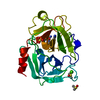

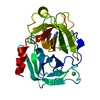

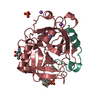
 Links
Links Assembly
Assembly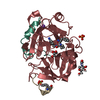
 Components
Components Homo sapiens (human) / References: UniProt: P00734, thrombin
Homo sapiens (human) / References: UniProt: P00734, thrombin Hirudo medicinalis (medicinal leech) / References: UniProt: P09945
Hirudo medicinalis (medicinal leech) / References: UniProt: P09945

 Homo sapiens (human) / References: UniProt: P00734, thrombin
Homo sapiens (human) / References: UniProt: P00734, thrombin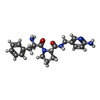








 X-RAY DIFFRACTION / Number of used crystals: 1
X-RAY DIFFRACTION / Number of used crystals: 1  Sample preparation
Sample preparation SYNCHROTRON / Site:
SYNCHROTRON / Site:  BESSY
BESSY  / Beamline: 14.2 / Wavelength: 0.9184 Å
/ Beamline: 14.2 / Wavelength: 0.9184 Å Processing
Processing MOLECULAR REPLACEMENT
MOLECULAR REPLACEMENT Movie
Movie Controller
Controller



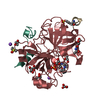
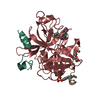
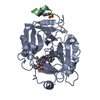
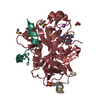
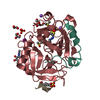

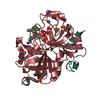
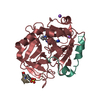
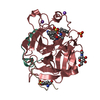

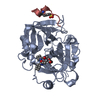

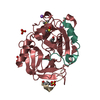
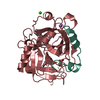
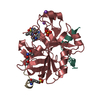
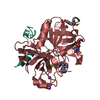


 PDBj
PDBj













